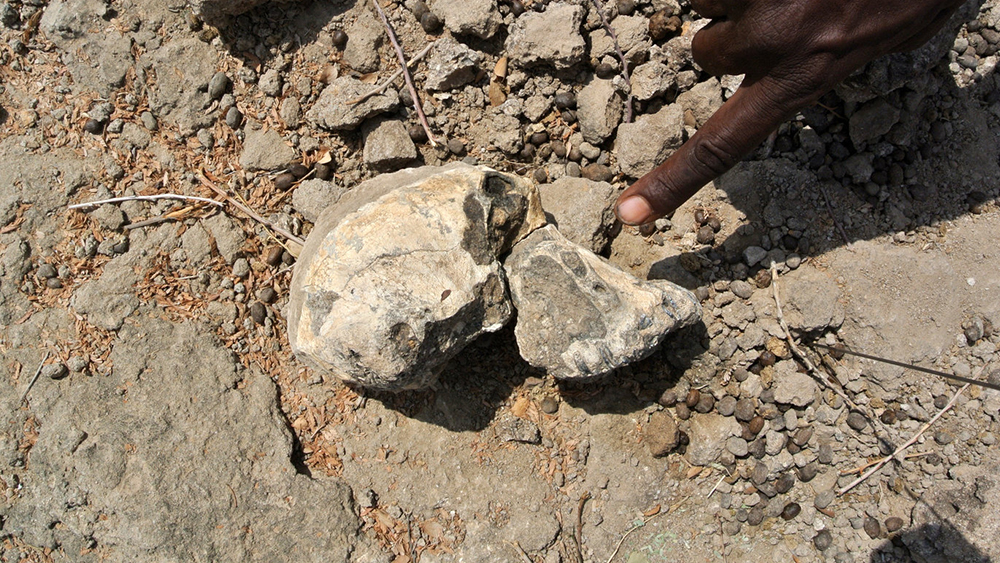A recent poll of college-age Americans showed that the single most convincing science-based argument for evolution is the lineup of supposed ape-like evolutionary ancestors of mankind.1 But epidemic disagreement among researchers over the relevance and position of every thus-far-proposed human ancestor undermines confidence in this fluctuating and fragmented fossil lineup. Creation researcher Marvin Lubenow called it “the fake parade” in his book Bones of Contention.2 A new ape-fossil study adds even more reason to decry this fossil parade as a fake.
Publishing in the journal Nature, a team of experts described a fossil skull that puts both a new face and a contradictory age onto an extinct ape variety previously known only from teeth and bone fragments.3 The team discovered the fossil in 2016 in the Afar region of Ethiopia. Early on, they recognized it as an australopithecine ape, but after analysis, they assigned it to the species anamensis.
Australopithecus anamensis supposedly evolved into Australopithecus afarensis—the most famous example of which is nicknamed Lucy—which some have asserted became humans. But many evolutionists see no anatomical link between this extinct ape kind and mankind. One zoologist admitted, “They are just apes.”4
Bible-respecting scientists see both Australopith varieties as members of the same created ape kind—now extinct. From this perspective, they would have lived at the same time but perhaps in different places, much like the two chimp varieties on Earth today. The common chimp Pan troglodytes has a wide habitat range, whereas the more rare pygmy chimp (bonobo) Pan paniscus appears to only live south of the Congo River in the Congo Basin.
The story of supposedly ancestral A. anamensis evolving into A. afarensis was easier to tell back when A. anamensis fossils occurred in rock layers below, and thus before, those of A. afarensis. But this newly described A. anamensis skull received an evolutionary age that overlaps its supposed descendant by 100,000 years. Lead author of the Nature paper Haile-Selassie told the Max Planck Institute, “This is a game changer in our understanding of human evolution during the Pliocene.”5
Talk about an overstatement. Rather, this is a game-ender for merely the Australopith backstory of one of the many human evolution narratives. The long overlap in evolutionary time erases notions of an ancestor-descendant relationship between these extinct ape varieties, but leaves intact the Genesis-friendly model of variations within kinds.
References
1. Biddle, D. A., and J. Bergman. 2017. Strategically dismantling the evolutionary idea strongholds. Journal of Creation. 31(1): 116-119.
2. Lubenow, M. 2004. Bones of Contention. Grand Rapids, MI: Baker Books, 167.
3. Haile-Selassie, Y. et al. 2019. A 3.8-million-year-old hominin cranium from Woranso-Mille, Ethiopia. Nature. Posted on Nature.com before print, August 28, 2019, accessed September 2, 2019.
4. Lewin, R. 1987. Bones of Contention: Controversies in the Search for Human Origins. Chicago, IL: University of Chicago Press, 164.
5. A face for Lucy’s ancestor. Max Planck Institute. Posted on mpg.de August 28, 2019, accessed September 2, 2019.
Stage image: cranium of Australopithecus anamensis
Stage image credit: Copyright © Dale Omori, Cleveland Museum of Natural History. Adapted for use in accordance with federal copyright (fair use doctrine) law. Usage by ICR does not imply endorsement of copyright holders.
Dr. Thomas is a Research Associate at the Institute for Creation Research and earned his Ph.D. in paleobiochemistry from the University of Liverpool.

Fossil Ape Skull Is a Game Ender
The Latest
Puzzling Fossils at an Unlikely Time
Wherever and whenever life is found, it is incredibly complex. This certainly applies to cyanobacterial photosynthetic life that supposedly were some...
CREATION PODCAST
A Theory Designed to Be...Anti-Design | The Creation Podcast:...
Science is objective. At least, that’s what we’re told. But there are inherent issues with this statement that can...
Seeing the Case for Creation in Fruit Flies
Our brain is designed to smoothly and constantly process what we see via the incredibly sensitive photoreceptors (cones and rods) of our eyes.1...
Amazing Defense Systems
Bacteria (prokaryotes) are ubiquitous. A fraction cause disease in people, animals, and plants, but the majority are the foundation for the global food...
Octopus and Fish Plan a Complex Coordinated Hunt
The octopus—an invertebrate—never fails to surprise researchers with its incredible abilities.1,2
The octopus was designed...
A ''40 million year old'' 100% European Gnat
Finding well-preserved creatures in amber1 is a landfall for creation scientists, much like the numerous discoveries of soft dinosaur tissue...
CREATION PODCAST
The Undeniable Power of Narrative | The Creation Podcast: Episode...
Science is objective. At least, that’s what we’re told. But there are inherent issues with this statement that can cause...
Paintbrush of the Creator
Who doesn’t enjoy the amazing color patterns of butterflies?1,2 Such beautiful designs and construction do not reflect blind naturalistic...
November 2024 ICR Wallpaper
"Rejoice always, pray without ceasing, in everything give thanks; for this is the will of God in Christ Jesus for you." (1 Thessalonians 5:16-18 NKJV)
ICR...













